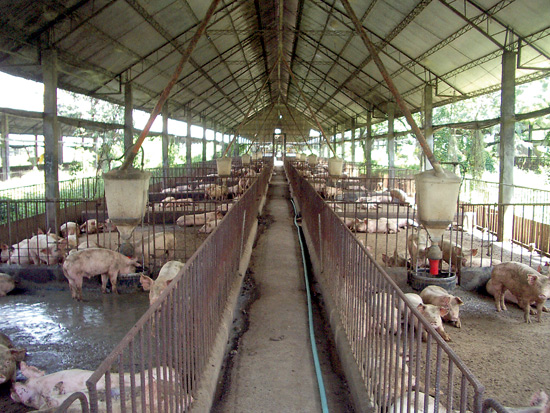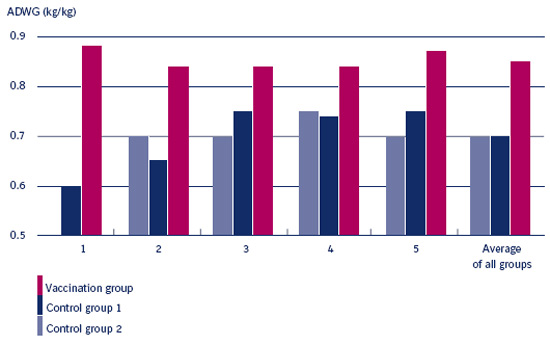8.3 What are the experiences with Enterisol® Ileitis in Asia and Australia?
Enterisol® Ileitis is registered in the Philippines, Australia and Thailand. Field trials for registration have been conducted in Japan in 2005 and 2006.
Multiple surveys during the last few years have shown that Lawsonia intracellularis is present in a similar manner in Asia and Australia as it is in the rest of the world (Holyoake et al. 1996, McOrist et al. 2003, Wang et al. 2006, Wei et al. 2006, Bulay et al. 2006, Park et al. 2006). The onset of infection however is often later and the severity of clinical symptoms is often lower in comparison to Europe due to the high prophylactic use of antibiotics.
The Philippines:
The efficacy of Enterisol® Ileitis was evaluated in a commercial swine farm in the Philippines. A 2,500 sow farrow-to-finish farm was chosen for the study. In total, 942 pigs were included and divided into three experimental groups. Group 1 received an oral 2ml dose of the vaccine at 22 days old by drencher. Group 2 was vaccinated orally via drinking water at 56 days of age delivered through the regular waterlines and drinking bowls during a 4 hour period. Group 3 continuously received the usual antimicrobial program being implemented in the farm during the conduct of the trial. Such antimicrobials included Chlortetracycline, Valnemulin, Tylosin, and TMPS. Body weights and feed intake were recorded per event in all groups from birth to market.
The performance of the vaccinated groups was higher than the control group (see Table 8.3 a). Vaccinated pigs, both the drench and drinking water group, grew faster and achieved considerably heavier market weights by 5.29kg and 5.23kg versus unvaccinated pigs, respectively. This equates to 28g more per day in favour of the group vaccinated by drench, and 31g more per day in favour of the group vaccinated by drinking water when compared to the control group. Moreover, the vaccinated pigs converted feeds more efficiently than the unvaccinated ones by as much as 0.55kg/kg, which is very substantial considering the prevailing feed cost.
Comparing the performances of both vaccinated groups, however, there was only a numerical advantage (ADWG, FCR) among the pigs vaccinated via drinking water (Group 2) as compared to the pigs vaccinated through drench (Group 1). This may be attributed to lower vaccination stress due to extra piglet handling, and the better distribution of the vaccine in the digestive tract brought about by higher fluid intake.
The animals are also classified in three groups throughout the nursery and fattening phase. Class A animals are the best growing animals with the highest health status, Class B animals are intermediate and Class C animals have the lowest ADWG and highest mortality. In Figure 8.3 a, the differences between the distribution of the animals over the classes is seen in relation to the treatment they received. It is clear that both vaccinated groups have a lower percentage of animals in Class C in comparison to the medicated animals.

Table 8.3 a
Growth Performances in the three groups (birth to slaughter)
In conclusion, vaccination with Enterisol® Ileitis, as compared to a purely antibiotic regimen, is a more economically efficient tool for the prevention of Ileitis due to Lawsonia intracellularis. (Bulay et al. 2006)

Picture 8.3 a (by H. Voets)
Problems with Ileitis in a Philippine farm.

Figure 8.3 a
Growth variability proportion between vaccinated and non-vaccinated animals. Class A animals are the best growing animals with the highest health status, Class B animals are intermediate and Class C animals have the lowest ADWG and highest mortality.
Japan:
In Japan, Lawsonia intracellularis is understood to be widespread and at least 95% of pig farms and 40 – 64% of pigs are infected with Lawsonia intracellularis.
The farm for clinical trial of the vaccine had 4,500 sows and a three-site rearing system with all in and all out. A total of 828 piglets born in the same house and aged 26 ± 5 days were used in this study. On the first day after introduction into nursery house, Group 1 was vaccinated with Enterisol® Ileitis by medication of the drinking water according to the recommendation and Group 2 was given an equivalent volume of vaccine diluent as placebo.
At 22 weeks the average body weights of Group 1 and 2 were 104 ± 10.0kg and 102 ± 11.0kg, respectively. Moreover, the difference of average daily gain was also statistically significant from 12 to 16 weeks (p = 0.006).
This difference of average body weight at 22 weeks is considered to be clinically relevant and economically beneficial at slaughter. Especially the significant difference of average daily gain established during 12 to 16 weeks, which corresponds with the onset of infection in the herd, may suggest that the negative effect on absorption of nourishment in guts by Lawsonia intracellularis can be prevented by vaccination with Enterisol® Ileitis effectively. (Yamaguchi et al. 2006)
Australia:
A 2,000 sow 3-site facility was chosen to demonstrate the efficacy of Enterisol® Ileitis in Australia. 8 week old pigs were held in separate barns and placed in traditional sheds with concrete floored pens and slurry pits. Seroconversion to Ileitis occurred at 13 to 16 week old. Pigs were vaccinated once orally with Enterisol® Ileitis via the drinking systems as weaners at 5 weeks old. Controls were sham-vaccinated with saline. From 3 to 6 weeks of age, all pigs consumed routine weaner rations containing 3,000 ppm pelleted Zinc Oxide and a blended feed acidifier (Acid LAC, Kemin).
There was a significant increase (p < 0.01) in the average grower to finisher weight gain (0.85kg/day) in vaccinates (n = 1076), compared to control groups 1 and 2 (0.70kg/day, n = 2139) in 5 different replicates (Figure 8.3 b).
Mortality levels in vaccinates (4.2% of intake) were markedly lower than controls (11.2%) – despite this farm being APP-free throughout. No confirmed deaths due to Ileitis occurred in vaccinates, while numerous cases were confirmed in controls.
The study conditions at the farm mimic normal field usages, where an entire group of a single sex of pig production were all vaccinated as a batch. When compared to groups of control pigs of the same sex on the same diet in identical barns at the site, the primary parameters of efficacy of this vaccine were consistently and significantly improved in vaccinates. (McOrist and Smits 2006).

Figure 8.3 b
ADWG of control versus vaccinated groups
© Boehringer Ingelheim Animal Health GmbH, 2006
All rights reserved. No part of this Technical Manual 3.0 may be reproduced or transmitted in any form or by any means, electronic or photocopy, without permission in writing from Boehringer Ingelheim Animal Health GmbH.






